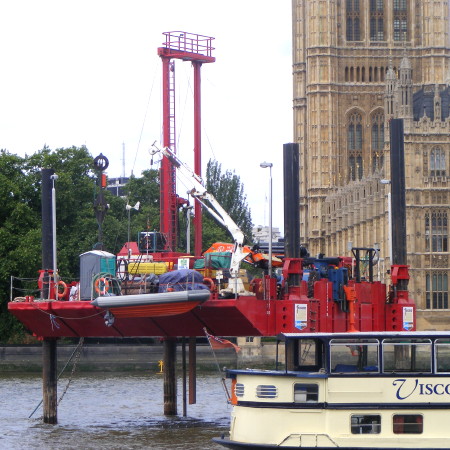Exploratory works for Thames Tunnel begin upstream of Westminster Bridge
A nine-month programme of borehole tests along the river for Thames Water's proposed Thames Tunnel has begun with the installation of a drilling rig near Westminster Bridge.

Thames Water wants to build a 20-mile sewer intended to significantly reduce levels of sewage entering the River Thames.
About 32 million cubic metres of untreated sewage – enough to fill the O2 Arena 15 times – currently flows into the river each year during rainfall.
The Thames Tunnel, which will broadly follow the course of the river, and the Lee Tunnel, a four-mile sewer to stop sewage overflows into the River Lee, are together known as the London Tideway Tunnels.
The borehole between Lambeth Bridge and Westminster Bridge will enable Thmaes Water to analyse the ground conditions that engineers digging the proposed tunnel are likely to encounter.
Further boreholes will soon be created near Bankside and London Bridge.
"The boreholes in the river are key to helping us develop a detailed design for the Thames Tunnel," says Peter Antolik of Thames Water.
"Ahead of submitting a planning application in 2011, we first need to build up a thorough technical understanding of the potential constraints along the proposed route.
"Prior to setting up the borehole rigs in the river, we have been liaising closely with the Port of London Authority and local councils to ensure we minimise noise and disruption."
A maximum of three rigs will be in place at one time for up to three weeks at each location.
Thames Water argues that regulator Ofwat could impose price caps on the company's water bills which would make funding the tunnel more difficult.
Comments
Share
The SE1 website is supported by people like you
More to read
- The Cut to be closed to through motor traffic 22 Aug 2020
- Thames Water thanks locals after six-month road closure 19 Jul 2020
- Water-less in Waterloo after Leake Street leak 8 Apr 2020
- Blackfriars Road reopens to traffic after month-long closure 24 Feb 2020
- Blackfriars Road to remain shut for another fortnight 1 Feb 2020
- Blackfriars Road: burst water main shuts Southwark Station 21 Jan 2020
- 30-tonne fatberg removed from sewers under Borough Market 16 Dec 2019
- Public water fountains coming to Guy's and St Thomas' hospitals 29 Aug 2018
- Blackfriars Road 'fatberg' to be dissected on Channel 4 24 Apr 2018
- Burst water main in Westminster Bridge Road 12 Apr 2018
Follow us
Email newsletter
For the latest local news and events direct to your inbox every Monday, you need our weekly email newsletter SE1 Direct.

